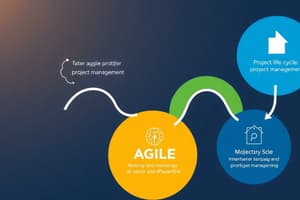Podcast
Questions and Answers
In a projectized organization, how are projects typically classified?
In a projectized organization, how are projects typically classified?
- By the functional department they belong to
- Based on the project itself (correct)
- By a combination of functional and project needs
- Based on the availability of resources
Which of these is a characteristic of a predictive project life cycle?
Which of these is a characteristic of a predictive project life cycle?
- A plan-driven approach, like the waterfall model (correct)
- Focus on rapid prototyping and deployment
- Iterative development with frequent reviews
- High degree of adaptability to changes
What is a primary benefit of using Agile methodology in project management, according to the text?
What is a primary benefit of using Agile methodology in project management, according to the text?
- Strict adherence to an initial plan
- Reduced need for detailed documentation
- Elimination of all risks
- Improved customer satisfaction (correct)
Which of the following is considered to be an Enterprise Environmental Factor that may influence project and project management processes?
Which of the following is considered to be an Enterprise Environmental Factor that may influence project and project management processes?
In the context of organizational power structures, what best defines the role of a 'coordinator'?
In the context of organizational power structures, what best defines the role of a 'coordinator'?
Which of these is a characteristic typically associated with an Agile team?
Which of these is a characteristic typically associated with an Agile team?
What does the Agile approach suggest about planning?
What does the Agile approach suggest about planning?
What is a key reason for adopting Agile software development?
What is a key reason for adopting Agile software development?
According to the Agile triangle model, scope has no impact on costs in Agile projects.
According to the Agile triangle model, scope has no impact on costs in Agile projects.
The type of organizational structure known for combining functional structure with project-based approaches is called a __________.
The type of organizational structure known for combining functional structure with project-based approaches is called a __________.
Flashcards
Enterprise Environmental Factor
Enterprise Environmental Factor
The collection of internal and external factors that influence project and project management processes.
Functional Organization
Functional Organization
A structure where functional managers make decisions, with varying degrees of project team autonomy.
Balanced Matrix Organization
Balanced Matrix Organization
Combines a functional structure with project-based elements, offering a balance of organizational control and project focus.
Predictive Life Cycle
Predictive Life Cycle
Signup and view all the flashcards
Iterative & Incremental Life Cycle
Iterative & Incremental Life Cycle
Signup and view all the flashcards
Agile Project Management
Agile Project Management
Signup and view all the flashcards
Adaptability in Agile Development
Adaptability in Agile Development
Signup and view all the flashcards
Visibility in Agile Development
Visibility in Agile Development
Signup and view all the flashcards
Agile Manifesto
Agile Manifesto
Signup and view all the flashcards
Agile Alliance
Agile Alliance
Signup and view all the flashcards
Study Notes
Agile Project Management
-
Organizational Cultures & Styles: Shared vision, mission, and values; risk tolerance; code of conduct, work ethics, and work hours; operating environment.
-
Organizational Communication: One factor for effective project management is good communication; stakeholders and project team communication is key.
-
Organizational Structures: Functional matrix (strong, weak, balanced); projectized; composite. Functional managers take decisions in functional structure, and functional or project teams work in projects.
-
Project Team: Groups of individuals work together to complete projects. Project life cycle (PLC) comprises phases from start to end; the name and number of phases are determined by the project.
- Important PLC characteristics: Predictive (plan-driven), iterative & incremental, adaptive (change-driven/Agile), starting.
-
Predictive Life Cycle: Waterfall, Prototyping.
- Project Phases: Predictable and sequential steps.
-
Agile Benefits: Better product quality, customer satisfaction, better control of projects, risk reduction, faster ROI. Agile team work, adaptability, high visibility.
-
Agile Team Characteristics: Self-empowered teams, teamwork and adaptability.
-
Agile Development Advantages: Visibility, Adaptability, Risk Management (risk reduction), Business Value.
-
Agile Triangle (Relationship between scope, time, and cost): Traditional vs Agile approaches. Fixed vs flexible.
Agile Software Development (further details)
-
Agile methodologies: XP, Scrum, DSDM, Adaptive Software Development, Crystal, FDD, Agile Alliance
-
Reasons for Agile Software Development: Ambiguous requirements; continuous changes; big upfront planning isn't practical; iterative/incremental development; frequent reflection; smaller, manageable steps.
-
Manifesto for Agile Software Development: Emphasis on individuals and interactions, working software, customer collaboration, and responding to change/flexibility, over processes and tools, comprehensive documentation, and strict adherence to plans
-
Agile Project Lifecycle (Software Development): Based on an individual approach, working software, customer collaboration, responding to change. Individual & interactions, working software, customer collaboration, responding to change.
Studying That Suits You
Use AI to generate personalized quizzes and flashcards to suit your learning preferences.



